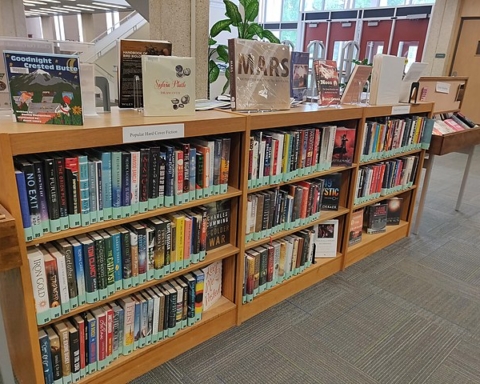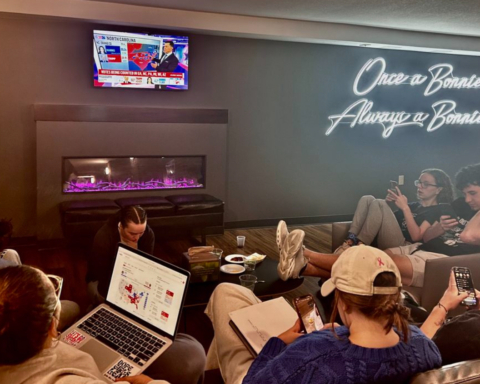While some incoming freshmen see the annual All Bonaventure Reads (ABR) book as a tedious task to overcome, getting a look at the work that goes into its selection might give way to some unexpected page-turning motivation.
According to Chris Brown, director of First-Year Experience and Orientation, the First-Year Experience program (FYE) was established in spring 2006, as the university hoped to improve freshman assimilation into campus life.
“There was a group of people who were brought together from across campus—faculty, staff, administrators—to look at what we can do to help improve the success and retention of first-year students,” Brown said. “…We were asked to dream big. To say, if we we’re creating a program for first-year students from the ground up, what would be components of it.”
Brown said, at the time, with common reads programs emerging on campuses across the United States, an ABR agenda seemed like the first logical piece to the First-Year Experience puzzle.
According to Brown, a common reads program is the academic manifestation of the Bonaventure community, as students are asked to both independently read and then interpersonally react to the assigned material.
To bring structure to the community-building idea, the university compiled a group of staff and faculty members, which served as the first ABR Selection Committee. The group worked exclusively, narrowing down potential reads, with a critical eye and lots of coffee. Brown added that the committee typically consists of 10-12 members.
Contenders for the ABR book have traditionally come from staff, faculty and student recommendations first, requested through a university Notice Board announcement, followed by the committee’s review of personal and publisher suggestions.
The first official ABR book was A Hope in the Unseen by Ron Suskind, which Brown said will always be one of his favorite selections.
Both Brown and Jean Ehman, director of the Teaching and Learning Center, agreed that the committee’s campus-wide impacts have grown over the past 10 years.
“Students’ connections to the book, as a general trend, have definitely increased,” Brown said. “Part of that is because we’ve been doing more with the book. As opposed to kind of handing it over to students in the summer and hoping that they read it, we now create several layers of programming, the essay contest and the connections. There’s more to the program.”
After Suskind delivered a lecture on campus, Brown explained, having the author visit became an ABR standard. Also, FYE holds a number of events to promote the book and encourages professors to integrate the literature’s central messages into classroom discussions, making it a part of freshmen’s daily personal and academic lives.
According to Brown, FYE partnered with the #RaceMatters incentive to host a number of discussions and lectures relating to this year’s selected read, Just Mercy: A Story of Justice and Redemption by Bryan Stevenson.
One of the incentive’s largest events, led by keynote speaker Anthony Ray Hinton, surrounded Hinton’s personal account of being wrongfully accused of murder and sentenced to 30 years in prison, due to racial injustice. Other speakers included Breea Willingham, Ph.D., assistant professor of criminal justice at Plattsburgh State University, who discussed race crimes in America, and David Kirkland, Ph.D., associate professor of English and urban education at New York University, who discussed racial bias in education.
Ehman, who has served as the committee’s chair since ‘07, explained that not only the program but the committee itself has grown. Ehman added that the committee has unofficially labeled themselves the “funnest group” on campus, due to the candid and conversational nature of their late-Friday meetings.
“Initially, it was an opportunity for a lot of us (staff and faculty members), who worked hard in a lot of different arenas on campus, to actually get to know one another—and that was a beautiful take-away from a professional point of view,” she said. “We were on very common ground and so…we were bonded by our love of reading and our love of freshmen.”
To Ehman, the ABR committee has provided her an interesting perspective on the Bonaventure community, especially with the addition of student representatives to the panel.
Starting only a few years ago, the ABR committee began recruiting students to take part in the monthly meetings, aiming to get a hands-on perspective regarding student needs.
Malaika Worsham, a junior sports studies major and ABR Selection Committee member, said her experience with the group has given her an unexpected appreciation for a book she once viewed as a “to-do.”
“Being on the ABR Selection Committee has taught me the importance of picking the right book,” Worsham said. “I never knew this much time and effort went into picking the book. I also never knew how much the community gets involved with picking the book. Being on this committee, you have to learn to trust the process. The book we pick can have a huge impact on people’s lives…”
Worsham added that the book the committee picks sends an important message to incoming freshmen and their families about what Bonaventure finds important, which makes the ABR Selection Committee all-the-more important.
While the ABR Selection Committee has grown to be one of campus’s most gripping incentives, Ehman said the group has always stayed focused on its main goal: engaging freshmen.
“Our premise has stayed the same, but we have evolved and we’re sensitive to topics that affect our freshman and our campus—and our world, also,” Ehman said. “That will be ever-evolving.”
mcgurllt14@bonaventure.edu








